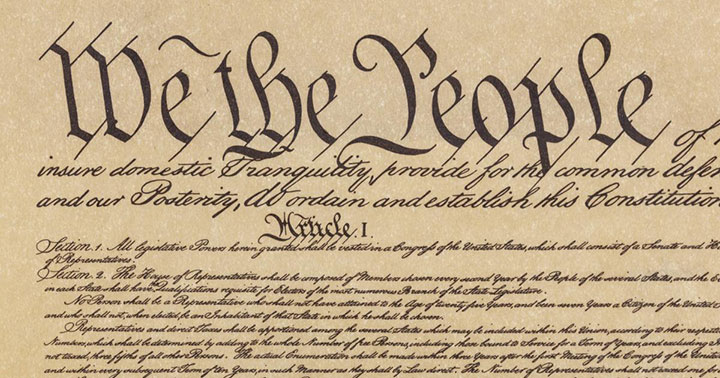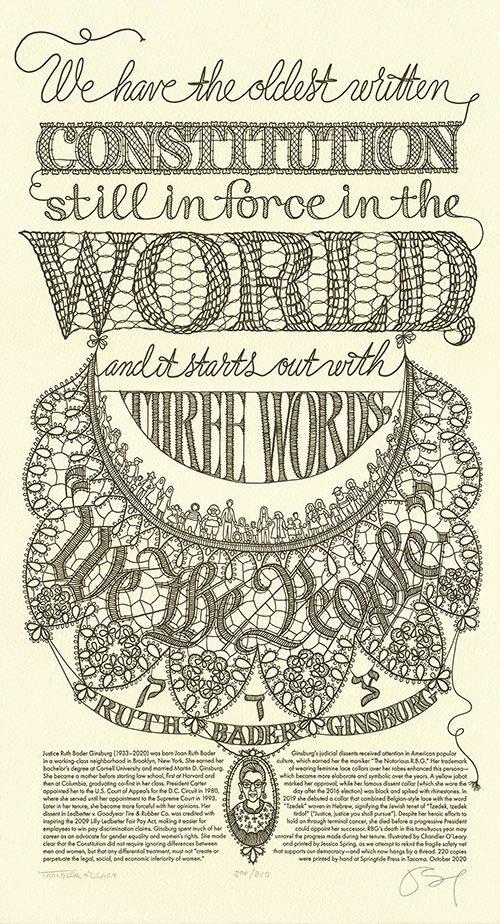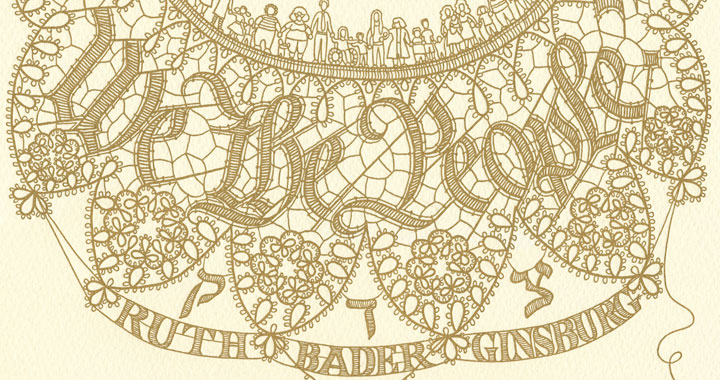We are less than a week from Election Day, and just six weeks following the death of Ruth Bader Ginsburg. We are still in shock, mourning her loss. The grief is compounded and exacerbated by the continuing twin pandemics of COVID-19 and flagrant racism enflamed by the current administration. We started the Dead Feminists series in 2008 as an urgent response to an ugly, divisive election—as artists with access to the power of a printing press, we had something to say. Upon RBG’s death, many women reached out in search of our reaction—after all, we had all been hoping against hope for months that she could hold on—a stitch in time to save nine (justices). Still, we hesitated, stunned and overwhelmed. Many of the women we feature are relatively unknown, with quotes that we joyfully amplify in print to tie to issues of social justice. We just weren’t sure we could add anything to the conversation by putting yet another RBG-themed illustration in the world.
But the Republican push to nominate and confirm Amy Coney Barrett was the tipping point. This third nominee of the current administration has been rammed through despite the overwhelming disapproval of the populace, and zero support from Democrats. It deliberately upsets any balance in the Supreme Court and threatens Roe v. Wade, the Affordable Care Act, marriage equality, immigrant rights, and many other long-since settled laws and norms supported by the majority of voters. The notion that Barrett, who has RBG to thank for the career doors opened for her, will take her place specifically to shut those doors again on her fellow Americans, is disgusting and disturbing. Her complete evasion of confirmation questions and the rushed nature of the hearings—all while the public was in the midst of voting—gives us much to fear, especially if (when?) the outcome of the election will be determined by the Supreme Court.
We have the oldest written constitution still in force in the world, and it starts out with three words, “We the people.”
– Ruth Bader Ginsburg
Our 31st broadside honors Justice Ginsburg and especially her work on behalf of women. She spent much of her legal career as an advocate for gender equality and women’s rights, winning many arguments before the Supreme Court. She advocated as a volunteer attorney for the American Civil Liberties Union and was a member of its board of directors (and one of its general counsel) in the 1970s. Ginsburg was hired as the first director of the ACLU’s Women’s Rights Project in 1972. In 1980, President Jimmy Carter appointed her to the U.S. Court of Appeals for the District of Columbia Circuit, where she served until her appointment to the Supreme Court in 1993. Between Sandra Day O’Connor’s retirement in 2006 and the appointment of Sonia Sotomayor in 2009, Ginsburg was the only female justice on the Supreme Court. During that time, Ginsburg became more forceful with her dissents, notably in 2007’s Ledbetter v. Goodyear Tire & Rubber Co. Ginsburg’s dissenting opinion was credited with inspiring the Lilly Ledbetter Fair Pay Act, signed into law in 2009, making it easier for employees to win pay discrimination claims. “To turn in a new direction, the court first had to gain an understanding that legislation apparently designed to benefit or protect women could have the opposite effect.”
Justice Ginsburg took pains to make clear that the Constitution did not require ignoring all differences between the sexes. “Inherent differences between men and women, we have come to appreciate, remain cause for celebration,” she wrote, “but not for denigration of the members of either sex or for artificial constraints on an individual’s opportunity.” Any differential treatment, she emphasized, must not “create or perpetuate the legal, social, and economic inferiority of women.”
American pop culture latched on to Ginsburg’s passionate dissents and sense of style, dubbing her “The Notorious R.B.G.” Most recognizable were the iconic collars she wore over her robes (although Justice O’Connor was known for wearing them, too). “You know, the standard robe is made for a man because it has a place for the shirt to show, and the tie,” Ginsburg said. “So Sandra Day O’Connor and I thought it would be appropriate if we included as part of our robe something typical of a woman.” Her first court portrait features a rather plain white collar worn by French justices, but in later years they became more elaborate. The favorite in her vast collection was a delicate French jabot made in South Africa (which she wore to Barack Obama’s first address to a joint session of the U.S. Congress in 2005). She wore different collars to reflect different legal opinions, including her famous “Dissent Collar,” black and studded with sharp-edged rhinestones. “When a justice is of the firm view that the majority got it wrong, she is free to say so in dissent. I take advantage of that prerogative, when I think it important, as do my colleagues.”
RBG’s collars are the most obvious point of entry for depicting her life and work visually—as evidenced by the veritable mountain of recent art made about her in recent years. But though much has been said and done along these lines already, we were deeply interested in the symbolic nature of each of her collars, and that is what most inspired our broadside. Handmade textiles (garments, gifts, tapestries, heirlooms, religious vestments, etc.) historically come imbued with symbolism anyway, with stories and significance worked into every stitch—and RBG obviously understood this. Her collars got more ornate and symbolic over time, and her use of them spoke volumes, even when she remained silent herself (she even wore her Dissent Collar the day after the 2016 election!). These collars became shorthand for “Notorious R.B.G.”, and a rallying symbol for the people who loved her. They became the thing we all latched onto to say farewell to her when she passed. The fact that Ginsburg died on Erev Rosh Hashanah (the eve of the Jewish new year) only heightened her cult appeal, catapulting her into legendary status. Jewish tradition holds that those who die on that day “are the ones God has held back until the last moment [because] they were needed most and were the most righteous,” wrote Nina Totenberg of NPR, just after RBG’s death. Such a righteous person is called a “tzaddik,” a Hebrew word that shares a root with the “tzedek,” the word for justice. May her memory be a revolution.
Our 31st broadside is both simple and complex—just like the underpinnings of our democracy. For the first time ever, we’ve printed the piece in just one color, an intentional choice to underline the solemnity of our collective loss. And right now, as we see it, the choices for our nation are laid out in stark black-and-white. We are holding our collective breath for an election that will resoundingly confirm the country’s desire to darn, repair, and salvage (selvedge!) our nation into a democracy that isn’t moth-eaten and full of gaping holes.

Within the simplicity of our color scheme, our design is incredibly intricate, inspired by historic lacemaking methods and other “women’s work:” knitting, tatting, and bobbin lace. (Not to mention the endless possibilities to reveal our bias for textile puns.) The words of RBG’s quote are connected by one long, fraying thread, looping and weaving itself into a collar in the shape of a delicate safety net below the linked hands of little tatted thread people. This represents our democracy—which was also hand-wrought and stitched together over the course of centuries, whose weft has become warped of late, and which could easily unravel with continued assaults. The lettering of the final words of the quote mirrors the original handwritten script of the preamble of the Constitution.
And more, our collar evokes RBG’s “Tzedek Collar,” one she debuted in 2019. This collar was designed by Michigan artist Marcy Epstein and gifted to Ginsburg in recognition of her human rights work. Inspired by historic Belgian lace, the collar includes beading that references sacred Judaic geometry, and three Hebrew letters: tsade, dalet, and kuf, (צדק) which form the word “tzedek.” This represents the Jewish tenet of “Tzedek, tzedek tirdof” (Justice, justice you shall pursue)—the phrase that Ginsburg had on display in her judge’s chambers. Those same three Hebrew characters are woven into our broadside, below the scalloped hem and above Ginsburg’s name.
Much like the impetus to create this print, our choice of the title was the result of community input. We had several options, but we remained undecided on Selvedge Our Democracy and Weave the People. So we decided to thread the needle and put it to a vote on social media—one vote per person, no Electoral-College or shadow-docket SCOTUS shenanigans. Weave the People won by a landslide.
• • • • • • • • • • • • • • • • • • • • • • • • • • • • • • • • • • • • • • • • • • • • • • • • • • • • • • • •
Weave the People: No. 31 in the Dead Feminists series
Edition size: 220
Poster size: 10 x 18 inches
Printed from hand-drawn lettering and illustrations on an antique Vandercook Universal One press, on archival, 100% rag (cotton) paper. Each piece is numbered and signed by both artists.
In honor of Justice Ginsburg’s contributions to the rule of law, we are donating a portion of our proceeds to the National Women’s Law Center, via an Action Grant from the Dead Feminists Fund. The NWLC fights for gender justice—in the courts, in public policy, and in our society—working across the issues that are central to the lives of women and girls.
UPDATE, 11/30/2020: We are now completely sold out. Reproduction postcards of the original black design are available in the shop. Thank you for your support!
UPDATE, 11/16/2020: We now have a one-print-per-person limit for what remains in the gold edition (see below), in order to make what remains in the edition available to as many people as possible. Thank you for your understanding!
UPDATE, 11/11/20: The edition sold out almost instantaneously—in twelve years of doing this series, this has never happened before! We are floored, and SO thankful for your support. Because this print has had such an overwhelming response, we have made an unusual decision. For the first time ever, we have printed a second, alternate edition, called Re-Weave the People. We normally never reprint our editions, and have very strong opinions about the practice and the risk of devaluing prints for our collectors. Because of this, we’ve set up some ground rules about this new edition:
• The broadsides are printed in gold ink, instead of black—both to differentiate them and to symbolize the preciousness of our democracy
• Still letterpress-printed by hand, still limited-edition, same paper, same price
• Gold prints are signed, but not numbered
• Gold prints are instead labeled with “APG” (“artist proof – gold”)
• There won’t be a third edition of this broadside (though postcards will be available in late-November)
• We will not be doing reprints for any of our older broadside designs
We released the first 150 prints in the gold edition, along with a few remaining APs (artist proofs) of the black edition left from cancelled orders, on Wednesday, November 11. The remaining gold prints will become available on Monday, November 16.
The best part, for us, about doing this second edition is that we get to celebrate the Biden/Harris victory and make more donations! We watched in awe as Stacey Abrams and her fellow Georgia organizers turned their state blue for the first time in decades—despite some of the worst voter suppression in the country (which cost Abrams the governorship two years ago). So in honor of their work, and in hopes that they might have success in the January run-offs, we are donating a portion of our proceeds to the New Georgia Project—a nonpartisan effort to register voters in the state of Georgia, particularly women voters of color, who are disproportionately disenfranchised there. But Abrams is far from alone in this work, and our democracy needs defending on the national front, too. So we will also be donating to the Brennan Center for Justice, a bipartisan nonprofit that fights on many fronts: defending our elections, strengthening the courts, battling gerrymandering, ending mass incarceration, enfranchising every American, and more. Both donations will come in the form of Action Grants from the Dead Feminists Fund.
Colophon reads:
Justice Ruth Bader Ginsburg (1933–2020) was born Joan Ruth Bader in a working-class neighborhood in Brooklyn, New York. She earned her bachelor’s degree at Cornell University and married Martin D. Ginsburg. She became a mother before starting law school, first at Harvard and then at Columbia, graduating co-first in her class. President Carter appointed her to the U.S. Court of Appeals for the D.C. Circuit in 1980, where she served until her appointment to the Supreme Court in 1993. Later in her tenure, she became more forceful with her opinions. Her dissent in Ledbetter v. Goodyear Tire & Rubber Co. was credited with inspiring the 2009 Lilly Ledbetter Fair Pay Act, making it easier for employees to win pay discrimination claims. Ginsburg spent much of her career as an advocate for gender equality and women’s rights. She made clear that the Constitution did not require ignoring differences between men and women, but that any differential treatment, must not “create or perpetuate the legal, social, and economic inferiority of women.”
Ginsburg’s judicial dissents received attention in American popular culture, which earned her the moniker “The Notorious R.B.G.” Her trademark of wearing feminine lace collars over her robes enhanced this persona—which became more elaborate and symbolic over the years. A yellow jabot marked her approval, while her famous dissent collar (which she wore the day after the 2016 election) was black and spiked with rhinestones. In 2019 she debuted a collar that combined Belgian-style lace with the word “Tzedek” woven in Hebrew, signifying the Jewish tenet of “Tzedek, tzedek tirdof” (“Justice, justice you shall pursue”). Despite her heroic efforts to hold on through terminal cancer, she died before a progressive President could appoint her successor. RBG’s death in this tumultuous year may unravel the progress made during her tenure. Illustrated by Chandler O’Leary and printed by Jessica Spring, as we attempt to reknit the fragile safety net that supports our democracy—and which now hangs by a thread. 220 copies were printed by hand at Springtide Press in Tacoma.

